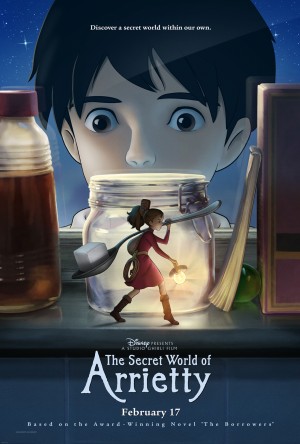
For a film so humble in its ambitions, it touches on some surprisingly resonant ideas about the transience of life. The story (directed by Hiromasa Yonebayashi with a screenplay written by Ghibli guru Hayao Miyazaki) begins with Arrietty (Bridgit Mendler) training with her father to be an independent “borrower,” someone who loots sundries from the house in which he or she is hiding. Arietty is soon spotted by a sickly human boy named Shawn. Shawn wants to make a friend and help out Arrietty’s family before his heart surgery; Arrietty wants to evade detection and make her parents proud by being self-sufficient. As the film unfolds, Arietty must face the possibility of having to leave her home and lose a dying friend.
In the human world, a gnomish housekeeper named Hara (Carol Burnett) senses something curious going on. To prove she’s not going crazy, she tries to capture the trio of tiny borrowers. Hara is the closest thing to a villain in the film, but she’s far from malicious—just a little unhinged. Burnett’s shrill antics are quite funny. Arnett and Poehler do a good job as well, playing lovable stereotypes (the former a quiet, square-jawed workman and the latter a frantic housewife).
But most impressive is the tiny world around Arrietty, which lends itself to delightful subtleties: a pin doubles as a sword, nails are used as steps, a postcard becomes a mural. The animation throughout is impeccable and the sound editing equally sharp, so that the textures and details in and around the house come alive. In fact, most Studio Ghibli films are compelling because of their beautiful details—be it Totoro’s rainy bus stop, or Kiki’s seaside bakery, or a secret bathhouse entrance in Spirited Away, or breakfast in a moving castle. Meticulous and expansive worlds, rather than heavy narrative arcs, take the spotlight.
This is especially true in The Secret World of Arrietty. In one early scene, for example, Arrietty’s father warns her of two distant rats scurrying in the walls of the manor. We might expect Arrietty to save her family later on by combating these rodents with her pin-sword, but instead we never see the critters again. This seems like a violation of the “rule of Chekhov’s gun” (filmmakers won’t show a loaded pistol without eventually using it!), but the rats are not meant to be villains; they are simply details that help color Arrietty’s intricate environment.
All too often, children’s movies conform to an adult’s idea of what they should be, centering on grandiose, moralistic narratives. By weaving a world together through small details, Arrietty kindles the innocence and awe of childhood in a more truthful way. The film doesn’t just look good; its space and mood evoke a mixture of longing, anxiety, and wonder we’ve all felt at the edge of the unknown. Arrietty’s secret world is a joy to explore.

